[Research Report] The left ventricular assist device market was expected to reach US$ 1,272.08 million in 2021 & it is expected to grow at a CAGR of 5.1% from 2022 to 2028.
Left ventricular assist device helps the left ventricle of the heart in pumping blood to the rest of the body. It is also known as a mechanical circulatory support device that helps in maintaining proper blood circulation within the body. The increase in prevalence of cardiovascular disorders and heart failure along with a significant rise in the geriatric and obese population drives the growth of the left ventricular assist device market. However, growing product recalls and complications associated with left ventricular assist devices hamper the market growth.
The report offers insights and in-depth analysis of the left ventricular assist device market, emphasizing various parameters such as market trends, technological advancements, market dynamics, and competitive landscape analysis of global leading market players. It also includes the impact of the COVID-19 pandemic on the market across all regions. Due to the COVID-19 pandemic, many health authorities focused on pandemic-related care. They avoided human contact due to growing transmission and strain on healthcare resources by postponing elective surgeries, suspending outpatient clinics, and triaging employees involved in urgent care. Furthermore, many countries imposed restrictions on nonclinical staff access to the facility and guests. Moreover, there was an increase in the prevalence of cardiovascular conditions among COVID-19 patients, which further created the demand for left ventricular assist devices, which resulted in market growth. Recent COVID-19 guidelines for healthcare professionals suggested a focus on urgent care and triaging cases to postpone elective surgeries and clinic appointments, with a transition to virtual-based care when appropriate.
Customize This Report To Suit Your Requirement
You will get customization on any report - free of charge - including parts of this report, or country-level analysis, Excel Data pack, as well as avail great offers and discounts for start-ups & universities
Left Ventricular Assist Device Market: Strategic Insights

-
Get Top Key Market Trends of this report.This FREE sample will include data analysis, ranging from market trends to estimates and forecasts.
Moreover, manufacturing companies of many left ventricular assist devices are responding to emergencies through various strategies such as manufacturing PPEs for healthcare workers, distributing pharmaceutical drugs, and other activities. Further, in November 2020, Medtronic and the Medtronic foundation committed the financial support of US$ 3.8 million on a global level to provide healthcare worker support in terms of food, operational support, mental health support, PPE kits, and others. Thus, the pandemic had a short-term negative impact on the left ventricular assist device market.
The left ventricular assist device market is segmented on the basis of type of flow, design, application, and geography. By region, the market is segmented into North America, Europe, Asia Pacific, the Middle East & Africa, and South & Central America.
Market Insights
Increasing Incidence of Target Diseases and Procedures
According to the World Health Organization (WHO), cardiovascular disease (CVD) is one of the leading causes of death across the world. A few main contributors that are increasing the prevalence of CVD and stroke are family history, ethnicity, and age. The prevalence of CVD is also growing due to tobacco use; high blood pressure (hypertension); high cholesterol; exercise lack; unhealthy diet; excessive alcohol consumption; and diseases such as dyslipidemia, obesity, and diabetes. As per the American Heart Association, ~41.4% of adults in the US will have hypertension by 2030 (an 8.4% increase from 2012). The organization also estimates that the global cost burden of CVD will reach US$ 1,044 billion by 2030, which was US$ 863 billion in 2010. Moreover, according to the WHO estimates, deaths due to CVD across the world will rise from ~17.9 million in 2016 to 23.6 million by 2030. Emory Healthcare report states that the US recorded ~5 million cases of congestive failure in 2022, and ~550,000 new cases were diagnosed every year in the country. Also, the country reports ~287,000 deaths due to heart failure every year.
As per Temple Health, 70.9% of patients received heart transplants within a year, and the shortest waitlist average was 55.2% in the US in 2021. The increasing the heart transplant waiting list globally has propelled the use of left ventricular assist devices (LVADs) for end-stage heart failure patients to increase the ejection fraction and prevent organ failure. Therefore, the rising prevalence of CVD and heart failure and the long waiting list for a heart transplant propel the adoption of LVADs, which drives the growth of the left ventricular assist devices market.
Type of Flow-Based Insights
Based on type of flow, the global left ventricular assist device market is segmented into pulsatile and non-pulsatile. In 2021, the non-pulsatile segment accounted for a larger market share, and it is further expected to register a higher CAGR in the market during 2022–2028.
Design-Based Insights
Based on design, the left ventricular assist device market is bifurcated into implantable ventricular assist devices and transcutaneous ventricular assist devices. The implantable ventricular assist devices segment held a larger market share in 2021 and is anticipated to register a higher CAGR during the forecast period.
Application-Based Insights
Based on application, the left ventricular assist device market is segmented into destination therapy, bridge-to-transplantation, bridge-to-candidacy, and bridge-to-recovery. The destination therapy segment held the largest market share in 2021 and is anticipated to register the highest CAGR during the forecast period.
The left ventricular assist device market players adopt organic strategies such as product launches, product approvals, and expansion to expand their footprint and product portfolio worldwide and meet the growing demand. In June 2020, Abiomed announced the US Food and Drug Administration (FDA) approval for its investigational device exemption application for starting an early feasibility study with a first-in-human trial for the Impella ECP heart pump.
Geography-Based Insights
By geography, the left ventricular assist device market is segmented into North America (the US, Canada, and Mexico), Europe (France, Germany, the UK, Spain, Italy, and the Rest of Europe), Asia Pacific (China, India, Japan, Australia, South Korea, and the Rest of APAC), the Middle East & Africa (Saudi Arabia, the UAE, South Africa, and the Rest of the MEA), and South & Central America (Brazil, Argentina, and the Rest of South & Central America).
Left Ventricular Assist Device Market Regional InsightsThe regional trends and factors influencing the Left Ventricular Assist Device Market throughout the forecast period have been thoroughly explained by the analysts at The Insight Partners. This section also discusses Left Ventricular Assist Device Market segments and geography across North America, Europe, Asia Pacific, Middle East and Africa, and South and Central America.
Left Ventricular Assist Device Market Report Scope
| Report Attribute | Details |
|---|---|
| Market size in 2021 | US$ 1.27 Billion |
| Market Size by 2028 | US$ 1.81 Billion |
| Global CAGR (2021 - 2028) | 5.1% |
| Historical Data | 2019-2020 |
| Forecast period | 2022-2028 |
| Segments Covered |
By Type of Flow
|
| Regions and Countries Covered |
North America
|
| Market leaders and key company profiles |
|
Left Ventricular Assist Device Market Players Density: Understanding Its Impact on Business Dynamics
The Left Ventricular Assist Device Market is growing rapidly, driven by increasing end-user demand due to factors such as evolving consumer preferences, technological advancements, and greater awareness of the product's benefits. As demand rises, businesses are expanding their offerings, innovating to meet consumer needs, and capitalizing on emerging trends, which further fuels market growth.

- Get the Left Ventricular Assist Device Market top key players overview
Company-Based Insights
ABIOMED Inc, Abbott Laboratories, Medtronic Plc, LivaNova Plc, Jarvik Heart Inc, Terumo Corp, Berlin Heart GmbH, BiVACOR Inc, Evaheart Inc, and BioVentrix Inc. are among the leading companies operating in the left ventricular assist device market.
Frequently Asked Questions
What are the driving factors for the left ventricular assist device market across the globe?
Which type of flow segment led the left ventricular assist device market?
Which application segment held the largest market share in the left ventricular assist device market?
Which design segment held the largest market share in the left ventricular assist device market?
What is meant by the left ventricular assist device market?
What is the regional market scenario of the left ventricular assist device market?
Who are the key players in the left ventricular assist device market?
- Historical Analysis (2 Years), Base Year, Forecast (7 Years) with CAGR
- PEST and SWOT Analysis
- Market Size Value / Volume - Global, Regional, Country
- Industry and Competitive Landscape
- Excel Dataset
Recent Reports
Testimonials
Reason to Buy
- Informed Decision-Making
- Understanding Market Dynamics
- Competitive Analysis
- Identifying Emerging Markets
- Customer Insights
- Market Forecasts
- Risk Mitigation
- Boosting Operational Efficiency
- Strategic Planning
- Investment Justification
- Tracking Industry Innovations
- Aligning with Regulatory Trends





















 Get Free Sample For
Get Free Sample For